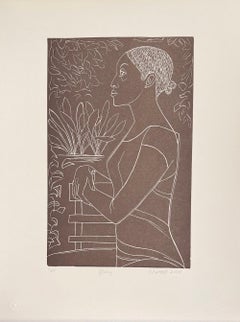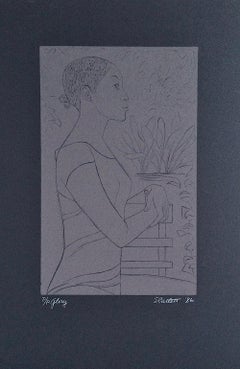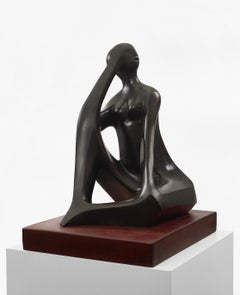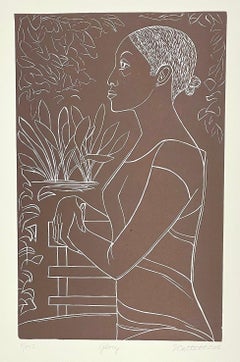Elizabeth Catlett Glory
Early 2000s Contemporary Portrait Prints
Linocut
Early 2000s Contemporary Portrait Prints
Linocut
Recent Sales
1970s American Modern Figurative Sculptures
Bronze
Early 2000s Contemporary Portrait Prints
Linocut
Early 2000s Contemporary Portrait Prints
Linocut
Early 2000s Contemporary Portrait Prints
Linocut
Early 2000s Contemporary Portrait Prints
Linocut
Elizabeth Catlett for sale on 1stDibs
Promoting social change was Elizabeth Catlett’s prime motivation as an artist. The granddaughter of enslaved people, Catlett was born in Washington, D.C., in 1915 and spent her adult life driven to create sculptures, prints and paintings that would reach, celebrate and uplift those who were barely visible in art.
“I have always wanted my art to service Black people — to reflect us, to relate to us, to stimulate us, to make us aware of our potential,” Catlett said of her work in the 1978 book Art: African American. She studied art history, drawing and other disciplines at Howard University, and as an MFA student at the University of Iowa, her mentor, the painter Grant Wood, advised her to “take as her subject what she knew best.” As she later told an interviewer, “The thing that I knew the most about was Black women, because I am one, and I lived with them all my life, so that’s what I started working with.”
The centerpiece of Catlett’s spring 1940 thesis project, Negro Mother and Child — a figure of a Black mother embracing her child, carved from Indiana limestone — was awarded first place for sculpture at the American Negro Exposition in Chicago held that year.
Catlett taught art at Dillard University in New Orleans — where she battled discrimination daily — and met her first husband, artist Charles White, while living in Chicago. She resigned from Dillard in 1942 and moved to New York City. There Catlett befriended painter Jacob Lawrence and studied lithography and other media at the Art Students League. Inspired by her studies with Ossip Zadkine, she began to incorporate abstract forms into her wood and stone sculptures.
In 1946, a grant supported her travel to Mexico to study its murals and graphic art. As Catlett had experienced the barbaric and deeply destructive system of racial segregation that the Jim Crow laws enforced in the United States, Mexico felt like a welcome escape. She would make the country her home and create much of her work there, divorcing White and marrying painter and printmaker Francisco Mora of the Taller de Gráfica Popular (People's Graphic Workshop), or TGP, in 1947. She collaborated with TGP, a graphic arts workshop dedicated to social issues located in Mexico City, on a number of works, including one of her best-known linoleum cut prints, Sharecropper (1952). The heroic depiction of an anonymous farm worker was intended to draw attention to the plight of Black tenant farmers who were ruthlessly exploited by the era’s white landowners.
Another iconic work of Catlett’s is Black Unity (1968), a raised fist sculpted from cedar, smooth and gleaming, with one side taking the form of two faces that resemble carved African masks. In the same year, the raised fist, a powerful symbol of the Civil Rights struggle and emblem of the Black Power movement, had been immortalized by two Black American athletes, John Carlos and Tommie Smith, who raised their black-gloved fists during the playing of the “Star-Spangled Banner” at the Summer Olympics in Mexico City.
Catlett was a professor of sculpture at the National Autonomous University of Mexico’s School of Fine Arts in Mexico City from 1958 until 1976, when she retired to focus on making art, exhibiting extensively in the years that followed. In 2003, she completed the Ralph Ellison Memorial in New York’s Riverside Park. That same year she received a lifetime achievement award from the International Sculpture Center. Her work is in the collections of museums worldwide, including the Smithsonian American Art Museum, Museum of Modern Art and the Metropolitan Museum of Art.
Find a range of authentic Elizabeth Catlett art today on 1stDibs.
A Close Look at Contemporary Art
Used to refer to a time rather than an aesthetic, Contemporary art generally describes pieces created after 1970 or being made by living artists anywhere in the world. This immediacy means it encompasses art responding to the present moment through diverse subjects, media and themes. Contemporary painting, sculpture, photography, performance, digital art, video and more frequently includes work that is attempting to reshape current ideas about what art can be, from Felix Gonzalez-Torres’s use of candy to memorialize a lover he lost to AIDS-related complications to Jenny Holzer’s ongoing “Truisms,” a Conceptual series that sees provocative messages printed on billboards, T-shirts, benches and other public places that exist outside of formal exhibitions and the conventional “white cube” of galleries.
Contemporary art has been pushing the boundaries of creative expression for years. Its disruption of the traditional concepts of art are often aiming to engage viewers in complex questions about identity, society and culture. In the latter part of the 20th century, contemporary movements included Land art, in which artists like Robert Smithson and Michael Heizer create large-scale, site-specific sculptures, installations and other works in soil and bodies of water; Sound art, with artists such as Christian Marclay and Susan Philipsz centering art on sonic experiences; and New Media art, in which mass media and digital culture inform the work of artists such as Nam June Paik and Rafaël Rozendaal.
The first decades of the 21st century have seen the growth of Contemporary African art, the revival of figurative painting, the emergence of street art and the rise of NFTs, unique digital artworks that are powered by blockchain technology.
Major Contemporary artists practicing now include Ai Weiwei, Cecily Brown, David Hockney, Yayoi Kusama, Jeff Koons, Takashi Murakami and Kara Walker.
Find a collection of Contemporary prints, photography, paintings, sculptures and other art on 1stDibs.
Finding the Right Prints And Multiples for You
Decorating with fine art prints — whether they’re figurative prints, abstract prints or another variety — has always been a practical way of bringing a space to life as well as bringing works by an artist you love into your home.
Pursued in the 1960s and ’70s, largely by Pop artists drawn to its associations with mass production, advertising, packaging and seriality, as well as those challenging the primacy of the Abstract Expressionist brushstroke, printmaking was embraced in the 1980s by painters and conceptual artists ranging from David Salle and Elizabeth Murray to Adrian Piper and Sherrie Levine.
Printmaking is the transfer of an image from one surface to another. An artist takes a material like stone, metal, wood or wax, carves, incises, draws or otherwise marks it with an image, inks or paints it and then transfers the image to a piece of paper or other material.
Fine art prints are frequently confused with their more commercial counterparts. After all, our closest connection to the printed image is through mass-produced newspapers, magazines and books, and many people don’t realize that even though prints are editions, they start with an original image created by an artist with the intent of reproducing it in a small batch. Fine art prints are created in strictly limited editions — 20 or 30 or maybe 50 — and are always based on an image created specifically to be made into an edition.
Many people think of revered Dutch artist Rembrandt as a painter but may not know that he was a printmaker as well. His prints have been preserved in time along with the work of other celebrated printmakers such as Pablo Picasso, Salvador Dalí and Andy Warhol. These fine art prints are still highly sought after by collectors.
“It’s another tool in the artist’s toolbox, just like painting or sculpture or anything else that an artist uses in the service of mark making or expressing him- or herself,” says International Fine Print Dealers Association (IFPDA) vice president Betsy Senior, of New York’s Betsy Senior Fine Art, Inc.
Because artist’s editions tend to be more affordable and available than his or her unique works, they’re more accessible and can be a great opportunity to bring a variety of colors, textures and shapes into a space.
For tight corners, select small fine art prints as opposed to the oversized bold piece you’ll hang as a focal point in the dining area. But be careful not to choose something that is too big for your space. And feel free to lean into it if need be — not every work needs picture-hanging hooks. Leaning a larger fine art print against the wall behind a bookcase can add a stylish installation-type dynamic to your living room. (Read more about how to arrange wall art here.)
Find fine art prints for sale on 1stDibs today.



